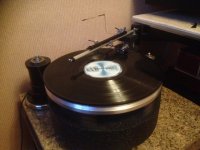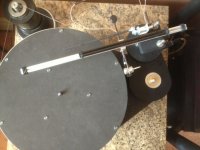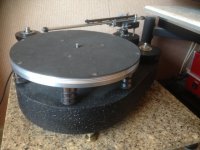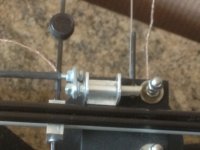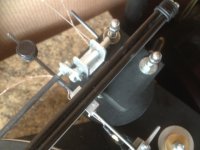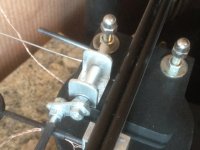Hi all.
I've just performed a very interesting little experiment.
Having reminded myself of my cats whisker test I just refined it a bit. I'm currently running my arm using ball races. These are Boca hybrid-ceramic 3x10x4.
My cat was unwilling to give me a whisker so I used one from my shaving brush, just as good. I superglued this to a rod with 30mm sticking out so that I could be as consistent as possible.
I balanced the arm to zero tracking force. I then used the hair to push the carriage side to side keeping the rod perpendicular to the movement. The first thing I noticed was the deflection was not even for left and right movement. I had levelled the arm with a spirit level as accurately as possible. I have just inadvertently discovered an even more accurate method of levelling. I fine tuned the level until whisker deflection was even then measured the deflection required to just move the carriage. Then using my digital stylus balance measured the force required to achieve the same deflection.
A force of 0.20g was required.
My carriage weighs 50g.
The coefficient of friction for the bearings must therefore be 0.004.
My cartridge has a dynamic compliance of 20um/mN. Static compliance is probably not far from this. A 0.2g force would give a stylus deflection of 0.04mm, not surprising we're finding it difficult to see this with the naked eye on a moving record.
A 0.04mm deflection at the stylus would mean that the cantilever is being deflected by 0.4-0.5degrees. Much more than I had anticipated.
I can't say I'm overly concerned by the level of LTA error as the sound quality is spectacular dispite it and the only way to significantly reduce it would require an air pump and loss of mechanical grounding.
Niffy
I've just performed a very interesting little experiment.
Having reminded myself of my cats whisker test I just refined it a bit. I'm currently running my arm using ball races. These are Boca hybrid-ceramic 3x10x4.
My cat was unwilling to give me a whisker so I used one from my shaving brush, just as good. I superglued this to a rod with 30mm sticking out so that I could be as consistent as possible.
I balanced the arm to zero tracking force. I then used the hair to push the carriage side to side keeping the rod perpendicular to the movement. The first thing I noticed was the deflection was not even for left and right movement. I had levelled the arm with a spirit level as accurately as possible. I have just inadvertently discovered an even more accurate method of levelling. I fine tuned the level until whisker deflection was even then measured the deflection required to just move the carriage. Then using my digital stylus balance measured the force required to achieve the same deflection.
A force of 0.20g was required.
My carriage weighs 50g.
The coefficient of friction for the bearings must therefore be 0.004.
My cartridge has a dynamic compliance of 20um/mN. Static compliance is probably not far from this. A 0.2g force would give a stylus deflection of 0.04mm, not surprising we're finding it difficult to see this with the naked eye on a moving record.
A 0.04mm deflection at the stylus would mean that the cantilever is being deflected by 0.4-0.5degrees. Much more than I had anticipated.
I can't say I'm overly concerned by the level of LTA error as the sound quality is spectacular dispite it and the only way to significantly reduce it would require an air pump and loss of mechanical grounding.
Niffy
Hi
It looks a fascinating arm and I am going to build one.
I was thinking of supporting the lower tubes on both sides of the turntable to make them more stable. Does anyone know of any problems with that?
Don
It looks a fascinating arm and I am going to build one.
I was thinking of supporting the lower tubes on both sides of the turntable to make them more stable. Does anyone know of any problems with that?
Don
Hi all.
My cartridge has a dynamic compliance of 20um/mN. Static compliance is probably not far from this.
Niffy
Actually I think dynamic and static compliance do differ a bit but I can't find any info on ortofons measurement techniques and opinions on the difference between dynamic and static on the web seem a bit confused.
nothing wrong with that, stability is always welcome , one concern could be the placement of records on the turntable, for some people it may be a little cumbersome if the structure is "too intrusive" but much of this depends on you and your particular situation or requirements. and remember that in general is better to use a short wand as explained in previous post.I was thinking of supporting the lower tubes on both sides of the turntable to make them more stable. Does anyone know of any problems with that?
Don
Have been playing a little bit today fitted the cartridge and completed the wiring set it up to give it a test run and can say that it performed well sound wise though it needs tweaking. I cannot tell you how many times I was behind the setup looking for me balls. The enclosed runners makes it tricky to set the balls correctly but I've now had a lot of practice 🙂
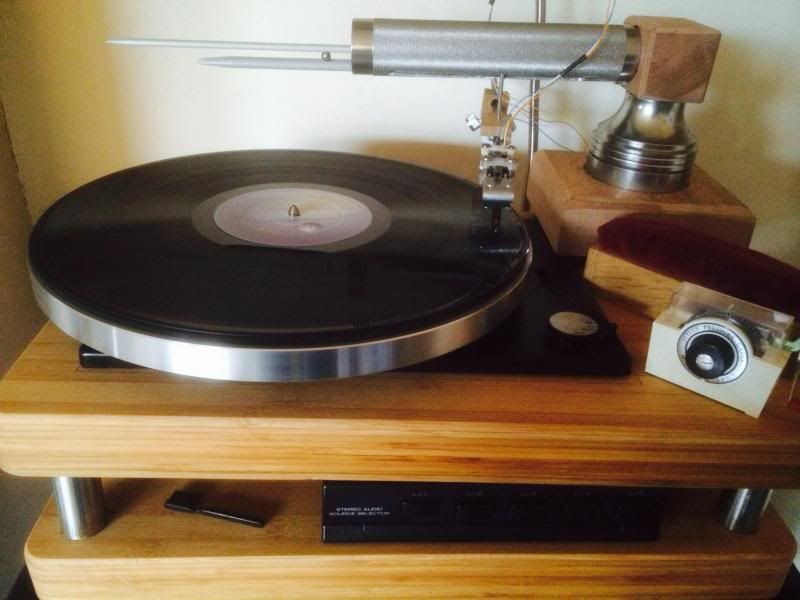
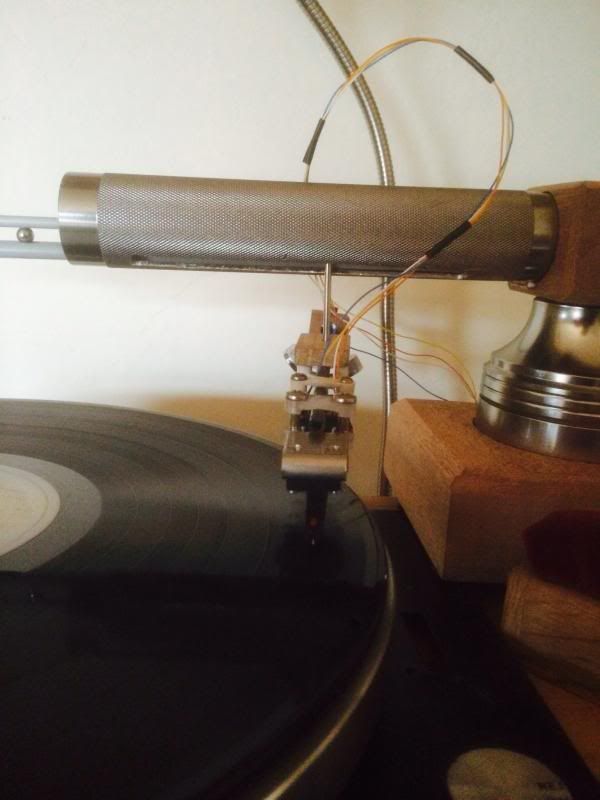


Squiffything that's look nice and quite interesting, did you use two "downward" rods or is just one holding the wand?, how did you place the rails inside the main tubing?
Just one, the other in the close up pic is the stem to my spotlight.
The lower rail is fixed into the wood and lays on the bottom of the tube
The lower rail is fixed into the wood and lays on the bottom of the tube
Arm-properly adjusted
Hello Everyone
After trying things out at the weekend with the arm wand about as steep as a ski jump, I then re-adjusted everything. It is now sounding superb and operates flawlessly. The whole affair is very stable and I don't think I'll be suffering wandering balls any more. What strikes me is the amount of 'air' around each instrument. More mods to come.........but a great design anyway!
Chris
Hello Everyone
After trying things out at the weekend with the arm wand about as steep as a ski jump, I then re-adjusted everything. It is now sounding superb and operates flawlessly. The whole affair is very stable and I don't think I'll be suffering wandering balls any more. What strikes me is the amount of 'air' around each instrument. More mods to come.........but a great design anyway!
Chris
Attachments
AN UPDATE
Hello Everyone
I've now been playing around with this arm for a couple of weeks and have to report I'm very pleased with its performance. Having leveled everything properly and ensuring the bolts are good and tight on the mounting block, everything was lifted to another performance level. Additionally, the low slung counterweight was very loose on the wand and so I added some 'O-rings' to ensure it was stable-the bass and separation have again gone up a couple of notches.
Wandering balls? Not a bit of it. As long as you are not ham-fisted, there aren't any issues.
Will have a few more ideas when I have the time- Good Friday and the weather in Cheshire super! Will it last?
As an aside-anybody been buying the jazz re-issues on DOL Records. Look them up on Amazon. Superb back catalogue and incredibly cheap. The recordings are superb and the vinyl is ultra-quiet. 150 g vinyl too- got the Miles at Carnegie Hall concert (2 lp's at £4.60 each- NEW) the recording blew me away!!
Finally a couple of piccies to whet your appetites.
Hello Everyone
I've now been playing around with this arm for a couple of weeks and have to report I'm very pleased with its performance. Having leveled everything properly and ensuring the bolts are good and tight on the mounting block, everything was lifted to another performance level. Additionally, the low slung counterweight was very loose on the wand and so I added some 'O-rings' to ensure it was stable-the bass and separation have again gone up a couple of notches.
Wandering balls? Not a bit of it. As long as you are not ham-fisted, there aren't any issues.
Will have a few more ideas when I have the time- Good Friday and the weather in Cheshire super! Will it last?
As an aside-anybody been buying the jazz re-issues on DOL Records. Look them up on Amazon. Superb back catalogue and incredibly cheap. The recordings are superb and the vinyl is ultra-quiet. 150 g vinyl too- got the Miles at Carnegie Hall concert (2 lp's at £4.60 each- NEW) the recording blew me away!!
Finally a couple of piccies to whet your appetites.
Attachments
very nice TT Chris, do you use it for different projects or are you planning on keeping it with this arm?
from what I can see you included a "lift" mechanism, did you make it from scratch or it comes from another TT and adapted to this tonearm?.
from what I can see you included a "lift" mechanism, did you make it from scratch or it comes from another TT and adapted to this tonearm?.
Hi
This deck is my 'test bed' as the arm changing process is so easy. It's a combination of an original Gyro platter (with my own weights added) a new Gyro bearing (best I've used) and a dc motor with silk drive thread. It's an excellent deck.
Re the arm lift-made from scratch, works very well and easy to make. I'll post some close-ups later on today.
Regards
Chris
This deck is my 'test bed' as the arm changing process is so easy. It's a combination of an original Gyro platter (with my own weights added) a new Gyro bearing (best I've used) and a dc motor with silk drive thread. It's an excellent deck.
Re the arm lift-made from scratch, works very well and easy to make. I'll post some close-ups later on today.
Regards
Chris
Hi Chris,
nice build! What's the ø of the tubes? I'm going to give this a shot and will order some aluminium tube, my guess ø is 3 - 5mm...
nice build! What's the ø of the tubes? I'm going to give this a shot and will order some aluminium tube, my guess ø is 3 - 5mm...
Hi
The tubes are 6mm aluminium. Top tubes are also 6mm but carbon fibre- I just had it lying around. How does it perform? Flawlessly. I had continual problems using ball races but with this, it has tracked everything I've thrown at it with no problems. And I have a few more improvements up my sleeve-when I get the free time of course!
Chris
The tubes are 6mm aluminium. Top tubes are also 6mm but carbon fibre- I just had it lying around. How does it perform? Flawlessly. I had continual problems using ball races but with this, it has tracked everything I've thrown at it with no problems. And I have a few more improvements up my sleeve-when I get the free time of course!
Chris
Had a day over the holiday replacing a front wheel bearing on our Ford Cougar. I was rewarded with a job lot of steel balls of a larger size than the ones I had been playing with. Never one to miss a chance to reuse and recycle two of the balls now grace the arm. Works a lot better in my setup and much easier to sort out due to the larger size. Not sure of the exact size but I would say 8 or 9 mm Still sounding lovely and open. Not perfect but I know its the wiring on this one. Once I get chance I will be trying a more flexible type.
Chris yours does look superb as usual. Pleased to hear it performs as good as it looks.
Chris yours does look superb as usual. Pleased to hear it performs as good as it looks.
Hi Chaps,
I think I must have read this thread a million times now; FANTASTIC!!
This is the sort of simple, beautiful idea that spawns a zillion options & outpourings. I'm chewing my own teeth in frustration at not being able to join in the fun (in the middle of a long-winded move & everything packed up). Huge thanks to Soyuz for opening up this marvellous thread.
Although in all probability unnecessary (as so many things are in hifi), I have been pondering the merits of multiple stacking to further reduce friction. Surely, if you have two stacks (one “linear ball race” on top of the other) friction will be halved? Or given that the lower race will only travel half the distance of the upper, will friction only be reduced by a third? Will multiple stacking help to average out track/ball noise anomalies, or would this cause a noise increase, and if so, could this be eliminated by immersing lower tracks in (very light) damping/lubricating fluid, i.e. paraffin?
I think I must have read this thread a million times now; FANTASTIC!!
This is the sort of simple, beautiful idea that spawns a zillion options & outpourings. I'm chewing my own teeth in frustration at not being able to join in the fun (in the middle of a long-winded move & everything packed up). Huge thanks to Soyuz for opening up this marvellous thread.
Although in all probability unnecessary (as so many things are in hifi), I have been pondering the merits of multiple stacking to further reduce friction. Surely, if you have two stacks (one “linear ball race” on top of the other) friction will be halved? Or given that the lower race will only travel half the distance of the upper, will friction only be reduced by a third? Will multiple stacking help to average out track/ball noise anomalies, or would this cause a noise increase, and if so, could this be eliminated by immersing lower tracks in (very light) damping/lubricating fluid, i.e. paraffin?
Hi Chaps,
I think I must have read this thread a million times now; FANTASTIC!!
This is the sort of simple, beautiful idea that spawns a zillion options & outpourings. I'm chewing my own teeth in frustration at not being able to join in the fun (in the middle of a long-winded move & everything packed up). Huge thanks to Soyuz for opening up this marvellous thread.
Although in all probability unnecessary (as so many things are in hifi), I have been pondering the merits of multiple stacking to further reduce friction. Surely, if you have two stacks (one “linear ball race” on top of the other) friction will be halved? Or given that the lower race will only travel half the distance of the upper, will friction only be reduced by a third? Will multiple stacking help to average out track/ball noise anomalies, or would this cause a noise increase, and if so, could this be eliminated by immersing lower tracks in (very light) damping/lubricating fluid, i.e. paraffin?
Unfortunately if you connect two bearings as you suggest only the one with lower friction will move. The sonic advantages of this design are probably largely due to it simplicity, adding extra rails and more complexity probably won't help sound quality. Of coarse I love to be proven wrong so knock up a test piece and see what happens.
Niffy
Friction
Hi Everyone
I don't believe friction is a limiting factor with this design. It's the lowest I've registered-even with commercial designs, and improvements in performance can be found elsewhere-mounting arrangements, rigidity etc. Also I believe that in the configuration suggested you would never get the thing to balnce properly as it woud be inherently unstable.
Chris
Hi Everyone
I don't believe friction is a limiting factor with this design. It's the lowest I've registered-even with commercial designs, and improvements in performance can be found elsewhere-mounting arrangements, rigidity etc. Also I believe that in the configuration suggested you would never get the thing to balnce properly as it woud be inherently unstable.
Chris
- Home
- Source & Line
- Analogue Source
- My Linear Tracker (a new variation perhaps?)
